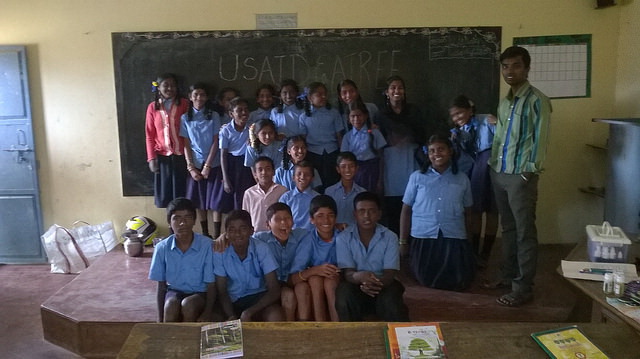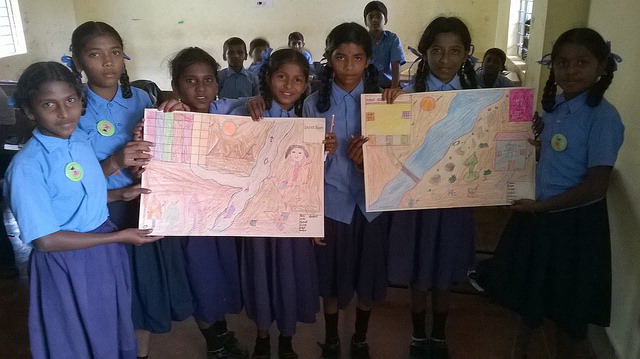The research team was able to procure village maps, high resolution satellite imagery to develop a GIS database on lakes and commons in the study area, mapping changes in lakes, wells, cultivation and tree cover from 1791 until 2015. Through field visits to over fifty villages, researchers identified 20 lakes for further in-depth study. In those lakes, they conducted water testing, interviews with local residents and government officials, taking measurements before and after monsoon season. The PEER team also conducted larger scale field visits on lakes across the city, as well as archival research on changes in governance from the colonial period onwards to investigate centralized vs decentralized governance’s impacts on the condition of the lakes.
Three female PhD students and one Master’s student worked on the project and used their research as part of their required theses. The PI incorporated material from the project for an undergraduate course on remote sensing she presented at Macalester College in Minnesota, a Master’s in Development course on land change at Azim Premji University, and a course on sustainability in planning and practice also at Azim Premji. As part of this latter course, students visited five community-restored lakes in Bangalore that the PEER project studied, using the information gathered from the project to guide field-based learning about issues of sustainability in practice in the context of Bangalore’s lakes.
By the time they submitted their final report in 2016, the research team had published 11 journal articles and two book chapters and made more than four dozen conference presentations and public talks. Researchers contributed input to lake restoration work by communities, civic and government bodies, and corporate groups. They also led heritage walks around lakes at two festivals, introducing participants to sacred and keystone trees, birds and insects, and fishing and grazing areas.
PublicationsH. Unnikrishnan, S. Mundoli, B. Manjunatha, and H. Nagendra. 2016. Down the drain: the tragedy of the disappearing urban commons of Bengaluru.
South Asian Journal of
Water Studies 5: 7-11.
https://www.researchgate.net/publication/301754513 H. Unnikrishnan, B. Manjunatha, and H. Nagendra. 2016. Contested urban commons: Mapping the transition of a lake to a sports stadium in Bangalore.
International Journal of
the Commons 10: 265-293.
https://www.jstor.org/stable/26522866 H. Nagendra. 2015. Wild beasts in the city. Seminar presentation, September 2015: 29-43.
https://publications.azimpremjiuniversity.edu.in/87/ D. Gopal, M. Manthey, and H. Nagendra. 2015. Vegetation in slums of Bangalore, India: Composition, distribution, diversity and history.
Environmental Management 55: 1390-
1401.
https://doi.org/10.1007/s00267-015-0467-3
S. Mundoli, B. Manjunatha, and H. Nagendra. 2015. Effects of urbanization on the use of lakes as commons in the peri-urban interface of Bengaluru, India.
International Journal of
Sustainable Urban Development 7: 89-108.
https://doi.org/10.1080/19463138.2014.982124 H. Unnikrishnan and H. Nagendra. 2015. Privatizing the commons: impact on ecosystem services in Bangalore’s lakes.
Urban Ecosystems 18(2): 613-632.
https://doi.org/10.1007/s11252-014-0401-0 H. Nagendra and E. Ostrom. 2014. Applying the social-ecological systems framework to the diagnoses of urban commons.
Ecology and Society 19(2): 67.
http://dx.doi.org/10.5751/ES-06582-190267 D. Gopal and H. Nagendra. 2014. Vegetation in Bangalore's slums: Boosting livelihoods, well-being and social capital. Sustainability 6(5): 2459-2473. https://doi.org/10.3390/su6052459
H. Nagendra, H. S. Sudhira, M. Katti, M. Tengö, and M. Schewenius. 2014. La urbanización y su impacto sobre el uso de la tierra, la biodiversidad y los ecosistemas en
la India.
Interdisciplina 2: 169–178. (Adapted from Nagendra, Sudhira, Katti et al. 2013).
http://dx.doi.org/10.22201/ceiich.24485705e.2014.2.46531 H. Nagendra, H. Unnikrishnan, and S. Sen. 2014. Villages in the city: spatial and temporal heterogeneity in rurality and urbanity in Bangalore, India.
Land 3(1): 1-18.
https://doi.org/10.3390/land3010001 Hita Unnikrishnan. 2013. Lakes in the Anthropocene.
Global Water News 13 (August 2013), pp 12.





